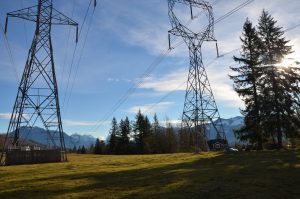
Powerlines create a serious hazard to aircraft. Approximately 66 aircraft strikes occur annually in the United States and an estimated 30% of these strikes result in fatalities. Strikes occurring at night or in limited visibility are particularly dangerous and have a 60% fatality rate. Helicopters are particularly at risk of striking powerlines, because they operate in the wire environment (below 1,000 feet) 90% of the time.
One of the things that makes powerlines so dangerous is that they can appear invisible to pilots. In only 40% of the aircraft strikes were pilots aware that the powerline or structure were there. In an effort to prevent these aircraft strikes, the Federal Aviation Administration (FAA) created both notice regulations for certain constructions and standards for the marking and lighting of powerlines.
14 C.F.R. Part 77.9 sets forth when developers are required to give notice of construction or alternation to the FAA, including:
- Any construction or alteration exceeding 200 feet above ground level;
- Any construction or alteration:
- within 20,000 feet of a public use or military airport which exceeds a 100:1 surface from any point on the runway of each airport with its longest runway more than 3,200 feet
- within 10,000 feet of a public use or military airport which exceeds a 50:1 surface from any point on the runway of each airport with its longest runway no more than 3,200 feet
- within 5,000 feet of a public use heliport which exceeds a 25:1 surface;
- Any highway, railroad, or other traverse way whose prescribed adjusted height would exceed the above noted standards;
- When requested by the FAA;
- Any construction or alteration located on a public use airport or heliport regardless of height or location.
The Notice of Proposed Construction or Alteration (FAA Form 7460-1) must be submitted at least 45 days before the start date of the proposed construction and can be filed manually or online at https://oeaaa.faa.gov/oeaaa/external/portal.jsp.
In addition to above notice requirements, the FAA published an Advisory Circular recommending standards for marking and lighting obstructions that have been deemed to be a hazard by the FAA. Generally, any construction or alteration exceeding 200 feet above ground level will need obstruction marking and/or lighting. Marker balls are often used to identify both powerlines where wires span long distances over canyons, lakes, or rivers and powerlines near airports. The marker balls must be placed on the highest wire or at the same level of the highest wire and each marker ball should be a solid color, such as orange, white, or yellow.
Some marker balls are required to be lighted. The FAA/OEAAA will specify the type of light and the requirements regarding the monitoring of lights. If there is alighting outage, it should be corrected as soon as possible. If the outage lasts longer than thirty minutes and affects a top light or flashing obstruction light, it should be reported by calling 877-487-6867 so a Notice to Airmen (NOTAM) can be issued. Noncompliance with notification procedures could result in penalties or monetary forfeitures.
If you or a loved one have been involved in an aircraft strike accident, it is important to understand your legal rights. You could be entitled to damages or compensation, especially if the powerline was not reported to the FAA or adequately marked. The experienced personal injury lawyers at Kraft Davies Olsson are available to consult with you regarding your entitlement to damages or compensation. Please call us at (206) 624-8844 or contact us through this website.
 Seattle Injury Lawyer Blog
Seattle Injury Lawyer Blog

